Fed Watching
Does it mean getting into Greenspan's head?
Evelina M. Tainer, Chief Economist
| "Alan Greenspan's statements have become like the Bible. Nobody reads them very closely and everybody quotes them. And they quote him on both sides of the argument," Sen. Phil Gramm (R-Texas) joked. (July 29, 1999, Chicago Tribune) |
The Popular Sport of Fed Watching
Economists have monitored actions by the Federal Reserve for many years. The field became particularly lucrative and glamorous in the late 1970s. Fed chairmen have come and gone, but few have become household names like Paul Volcker and Alan Greenspan. Volcker made a radical announcement in October 1979 that the Fed would target monetary aggregates (such as M1 and M2) instead of targeting the federal funds rate. Fed-watchers who estimated the daily reserve needs of the financial system, became the most sought-after economists by banks and investment firms. Fed watching was glamorous.
In the mid-1980s, the estimation of daily reserve needs and forecasts of M1 and M2 were still duties among Fed-watching economists. But the Fed was no longer targeting monetary aggregates directly and following economic indicators became relatively more important. President Reagan appointed Alan Greenspan as Fed chair in August 1987. This marks the beginning of the modern era. Fed watchers who only knew how to measure reserve needs or how to estimate the weekly monetary aggregates were relegated behind the "real" economists; that is, economists monitoring the real (non-financial) side of the economy. Economic indicators became king.
Indicators followed by the Fed… indicators followed by the Fed's Chairman
The goals of the Federal Reserve have generally been the same throughout its history. " . . . to promote effectively the goals of maximum employment, stable prices, and moderate long term interest rates."
By definition, then, indicators that reveal inflation become important ones to follow. Federal Reserve policy-makers have long monitored the consumer price index (CPI) and the producer price index (PPI). They have also followed commodity prices. The Fed watches the employment report because it reveals labor market conditions. The Fed clearly is concerned with economic growth and follows trends in gross domestic product (GDP). When we come down to the nitty gritty, Fed policy makers have long followed most of the economic indicators that are financial market favorites.
But the arrival of Alan Greenspan to the hallowed halls of the Federal Reserve brought renewed attention to the detailed monitoring of economic indicators. Early on, financial market participants learned that the NAPM was a Greenspan favorite. It had not been a major market moving indicator until 1987. Greenspan also had noted at the time, that he watched the supplier delivery component of the NAPM. The stock market crash of 1987 revealed another Greenspan favorite: consumer confidence surveys.
Fast forward to the 1990s and Greenspan revealed labor market indicators that were important. For instance, he regularly monitored the quit rate in the mid-1990s when the unemployment rate was approaching 5.8 percent. At the same time, a greater significance was attached to the employment cost index.
Getting inside Greenspan's head
In the July 5 issue of Business Week, commentator Peter Coy listed some indicators that he thought were Greenspan favorites - at least right now. We look at some of these indicators along with those we have found to be key indicators.
Inflation
Only the Fed can control long term price stability. The inflation indicators, in a sense, are obvious. The most common of all is the consumer price index. The reliability of this indicator has been questioned in the past few years as policy-makers have attempted to reduce increases in entitlements - which are contractually tied to the CPI. The Boskin Commission reported in 1996 that the CPI overstated the "true" inflation rate by at least one percentage point, but possibly by as much as 1-˝ percentage points. The Bureau of Labor Statistics is conducting ongoing research to improve measurement of inflation. Several improvements were introduced in the past few years that would reduce the overstatement of inflation in the CPI.

Nonetheless, Alan Greenspan prefers the price index for personal consumption expenditures (PCE) that is available monthly and quarterly as part of the GDP report. Unlike the CPI, which is a fixed basket of goods, the PCE deflator allows consumers to substitute alternative goods that are lower priced. The trends are likely to be the same. The chart above compares year-over-year changes in the two measures. Both are rising on a year-over-year basis, but the PCE deflator is increasing less than 1 ˝ percent, about ˝ point less than the CPI.
The employment cost index remains an important measure of inflation in the labor markets. The idea here is that accelerating compensation costs would lead to consumer price inflation as companies try to offset labor costs with increases in prices of the goods and services they produce. Last week's spurt in the ECI spooked market players. This index tends to be more reliable on a year-over-year basis than the quarterly changes. Despite an uptick in the second quarter, the overall index remains subdued.
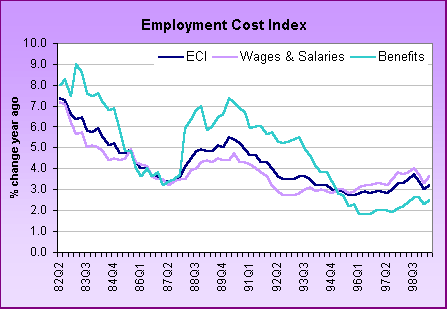
Gold prices have often been considered an inflation-hedge. Gold prices were relatively stable through this business cycle. In recent months, prices have actually plunged. Many central banks have either announced their intentions to sell gold reserves, or have already done so. However, analysts who closely monitor gold prices and production indicate that the gold sales are just a drop in the bucket compared with the total supply of gold. Thus, the gold sales would not be a major cause for the recent price decline. In his congressional testimony in June, Greenspan indicated his belief that the drop in gold prices reflects a favorable overall long-term outlook on inflation.
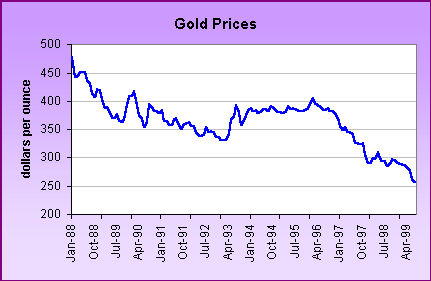
Financial Markets
Fed policy-makers all follow stock and bond markets very closely even though it isn't their intention to affect them. Greenspan made his feelings known about the stock market when he commented on the "irrational exuberance" of the market several years - and several thousand points (on the DJIA) ago. There is no question that market levels and market activity affect consumer and business behavior. The long-term bull market in equities has created a consumer shopping frenzy. Consumers are spending considerably more than they are earning because they feel "wealthier" from the unrealized gains in their portfolios.
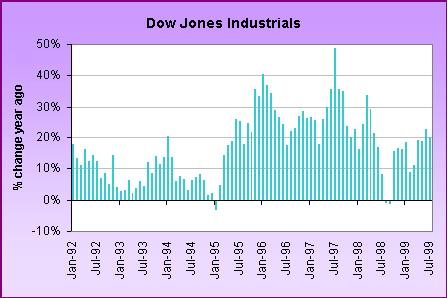
Behavior in the bond market is also relevant. When interest rates are rising, the cost of borrowing increases. Higher mortgage rates reduce affordability and housing construction. Higher interest rates also reduce business spending. Conversely, a low interest rate environment points to a booming economy (as we've seen). Policy-makers are hoping the recent uptick in rates will curtail the housing market and related industries.

Economic Growth
The civilian unemployment rate indicates the utilization of the nation's labor resources. When the unemployment rate is high, workers are not likely to demand higher wages because they are happy to have jobs. When the unemployment rate decreases sharply, employees are more likely to expect wage gains - or find another employer who will give better wages, salaries and benefits. The lower the unemployment rate, the more difficult it is to maintain price stability because higher wages eventually lead to higher consumer prices (or so the theory says).
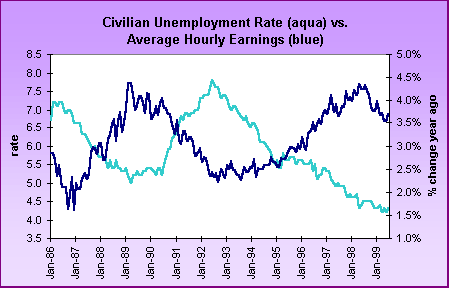
The unemployment rate depends on the number of unemployed persons in the labor force. Not everyone in the population is actively looking for employment - and thus the labor force is changeable. The pool of available labor is a more comprehensive figure, which also considers those not currently in the labor force, but who might like to work. Incidentally, more people are willing to work when the going wage rate is higher.
An economy benefits from productivity increases because it allows greater production capacity with no additional increases in labor. The standard of living increases because wage earners get increased wages - which are not inflationary. Productivity trends have been favorable in the 1990s; Greenspan believes the trend could be favorable for a longer period of time, but the growth rate of productivity may slow down. This would make it more difficult to see higher wages without higher prices.
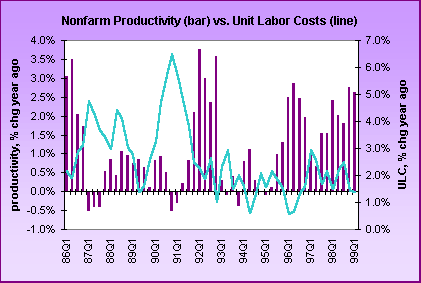
THE BOTTOM LINE FOR INVESTORS
Fed watching used to be a sport for economists who translated fed-speak for financial market players. Now, more individual investors follow economic trends along with daily (and hourly) changes in stock and bond prices. Individual investors are more inclined to make their own assessments of comments by Fed chairman Alan Greenspan.
The Fed chairman has brought greater transparency to Fed actions. But when the institutional framework was one with virtually no transparency, the relative term is misleading. Greenspan and fellow members of the FOMC often give their views on economic conditions, inflation, and the potential for Fed policy changes. But for the most part, their explanations (along with Greenspan's) are as clear as mud.
Do follow the Greenspan cadre of indicators. Do pay attention to the chairman's remarks. But the chances of understanding him are 50/50 at best. Even when he tells us the indicators he monitors, you that there are many more indicators actually on his screen. And then… there is always "anecdotal evidence."
Market players will focus all their attention on the Fed every day in August until the FOMC meets on August 24. Most participants are currently expecting the Fed to raise the federal funds rate by 25 basis points to 5.25 percent. Beware. Daily indicator announcements, which reveal different views on the economy, will no doubt shift the balance of expectations on the potential Fed rate hike.